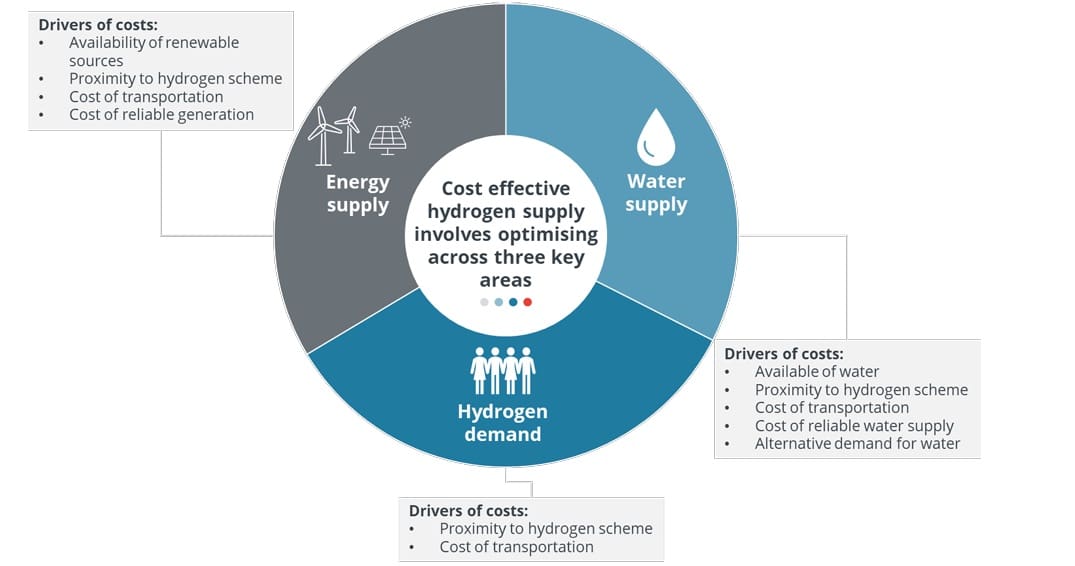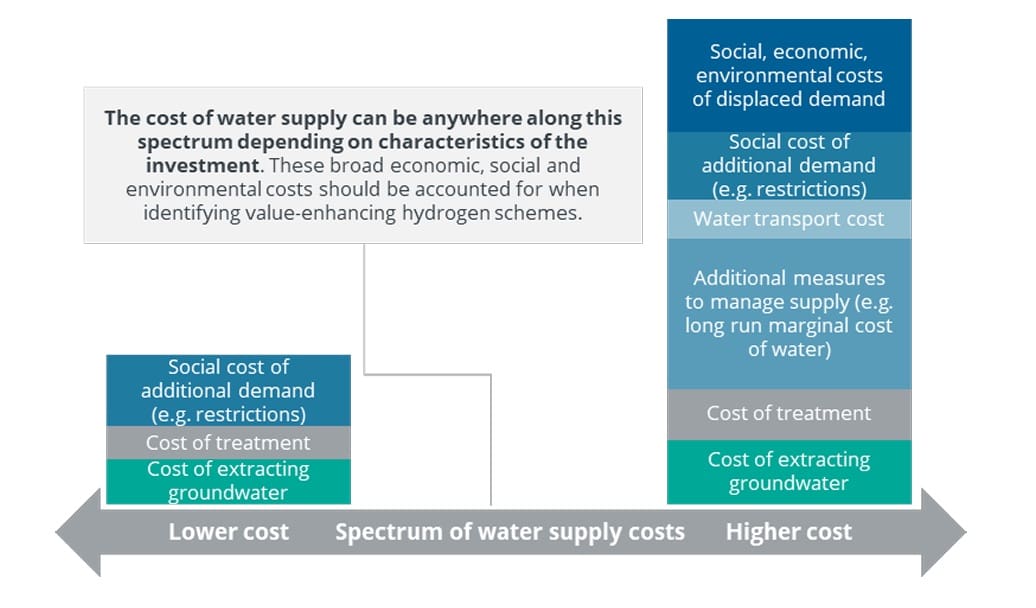The economics of water security in Australia’s hydrogen transition
Hydrogen gas has been hailed as the next big clean energy source, and Australia, with its abundance of renewable energy potential, is seen as well positioned to lead the charge to net zero. Governments and utilities are increasingly turning their focus to how the potentially large but uncertain water requirements to support Australia’s hydrogen transition can be met.
The quantity and variability of Australia’s water resources compared with other continents is well known, as are the expected reductions in average groundwater and surface water supplies available for consumption. The challenge for Governments and utilities is how to plan for and deliver water services to meet growth in underlying demand as well as potentially large but uncertain growth in industrial water demand – including to support Australia’s hydrogen transition.
In this context, it is critical that a sound economic framework is utilised to evaluate supply and demand side measures to meet potential growth in water demand, and provide efficient price signals to water users relating to the economic, social and environmental cost of water supply. This bulletin explores how integrating the economics of water security early in the hydrogen planning process can support informed decisions about how this transition occurs, including the location of hydrogen assets and their water sources, and ensure investment in water supply occurs when and where it maximises value to the community.
Australia’s hydrogen transition could have significant water requirements
Demand for ‘clean’ or ‘green’ hydrogen is expected to dramatically increase over the next decade as it replaces other hydrocarbon-based energy sources, such as liquid fuels for vehicles and natural gas for electricity generation and heating. Australia appears well placed to take advantage of increasing global momentum for clean hydrogen with big ambitions to grow our domestic hydrogen sector, with the “aim to position our industry as a major global player by 2030.”[1] Significant resourcing including state and private funding is being committed to support this ambition.
Year-round access to a secure source of water is critical for the delivery of Australia’s hydrogen transition. The National Hydrogen Strategy notes that water required for a large-scale hydrogen production industry will be significant. Given uncertainty around the future growth of Australia’s hydrogen sector, estimates of future water demand vary, ranging from just under the current annual supply for the whole of Southeast Queensland,[2] to around one-third of the water currently used by the Australian mining industry.[3] While the water demand is uncertain, in either scenario, it is potentially significant.
The National Hydrogen Strategy acknowledges that “Australians will want the new jobs and growth of clean hydrogen to be achieved without compromising safety, cost of living, water availability, access to land or environmental sustainability”.[4]
It notes that Australia will therefore need to consider how to balance hydrogen’s demands with other water priorities.[5] Some of which “may have higher economic, social or cultural value.” [6]
Delivering cost-effective hydrogen is likely to be a complex optimisation problem
The National Hydrogen Strategy states that “the most ideal sites for production facilities will have access to renewable electricity and water supplies”. [7]
Implicit within this is that there is a complex optimisation across numerous input and output/product markets – whether to transport energy, water and/or hydrogen.
For example, the Hunter Valley Hydrogen Hub on Koorangang Island was chosen as the location for a hydrogen hub based on its “proximity to high energy users, existing skilled workforce, existing energy infrastructure and land available for complementary businesses.”[8]
The Water Services Association of Australia states that: “For hydrogen production, 11% of Australia is suitable when considering energy needs only. This is reduced to only 3% when factoring water and transport infrastructure”.[9]
A key element when considering the cost of water in this optimisation is:
- The financial cost of water supply which is driven by water availability and at what price;
- Broader social, economic and cultural costs of accessing or transporting water;

The costs of water supply are variable but in many places are already increasing
The challenges in providing water security in Australia are well known.
Australia has a highly variable climate and set of rainfall patterns. Changes to rainfall patterns, declining groundwater availability and changes to water allocation (in part related to increasing environmental considerations)—all increasingly exacerbated by climate change— are reducing the capacity of existing and primarily climate dependent systems to supply water to the community.
Alongside this, water demand particularly in many urban areas is expected to grow as result of population growth, increasing temperatures and evaporation rates and community expectations for irrigated ‘cool green’ communities.
For this reason, in many urban supply areas, water security is increasingly being met by climate independent sources of supply (such as desalination and recycling facilities) combined with water conservation and demand management. While often cost effective relative to investment in more traditional climate dependent sources (such as new dams), these measures are increasing water supply costs over time, reflected in higher water usage prices.[10] The era of low-cost water is over.
The National Hydrogen Strategy notes that other uses for water may have higher economic, social or cultural value.
However, the impact on availability of water and/or other users, will vary depending on site specific characteristics, such as the size of the hydrogen scheme, the supply and demand balance in the area and the other competing water uses.
In some cases, investment in a hydrogen scheme that displaces other water demand can deliver a net benefit to the community (i.e. where hydrogen displaces low-value demand).
Identifying and enabling investment in these value enhancing opportunities for hydrogen production requires identifying the range of economic, social and environmental costs and benefits of water supply.
In broad terms, in rural areas the cost will largely by the social and environmental costs of displacing current users. In metropolitan areas it could be the cost of measures to increase supply or where this is not possible, to manage demand.
Rural areas
Non-metropolitan areas are likely to be closer to the source of renewable energy and water supply, but further away from hydrogen demand (for example, export infrastructure).
In addition, while water licences can appear to be a relatively cheap source of water, without access to a high security access licence, water may not be available when it is needed.
In many rural regions, additional water supply options can be limited, which means that the cost of meeting the additional demand associated with the hydrogen scheme can be significant. Inland desalination can be prohibitively expensive, and many communities rely almost 100% on rainfall dependent water sources, which are becoming a less and less secure source of water.
In the instance where proponents can access a secure licence at a reasonable price, as most rural water systems are fully allocated, providing water to the hydrogen scheme is likely to displace current users, such as farmers and households.
This displacement of demand can generate a range of economic, social and environmental impacts and can present equity and socio-economic concerns, especially when the water is used to provide hydrogen for export to other countries.
Even in the instance where there are allocations available (the hydrogen scheme does not displace demand), at a minimum, the high reliability requirements of the hydrogen scheme would increase the risks and variability to other users.
This highlights the need for an economic model to help understand the socio-economic impacts of allocating water to a hydrogen scheme. This is similar to analysis that we undertook to help understand the impact of Basin Plan water recovery, that has significantly reduced water available to irrigators, industry and other water users, to improve environmental outcomes.[11]
Metropolitan areas
Alternatively, the hydrogen scheme could be located close to metropolitan areas, such as near Newcastle or Perth. This is likely to be located near the source of hydrogen demand (both domestic demand and export infrastructure for international demand) but can require transportation of the energy. It also presents unique water security challenges.
While connecting a hydrogen scheme to the existing water supply may seem like a simple solution (i.e. use what we already have), doing so will subject the plant to broader, complex water security rules, regulations and planning impacts, as a large customer in a bigger water supply system, which could have implications for secure hydrogen production (for example, hydrogen production may need to be subject to water restrictions).
As shown in the graphic below, connecting the hydrogen scheme to the existing water supply, is likely to bring forward investment by a number of years, and/or trigger additional investment, in water supply or demand measures. These additional measures often represent more costly water supply options, as the lower cost options, such as surface and groundwater, have been fully utilised. This means that even in the presence of cost reflective prices, water prices are likely to increase in future.
While wastewater recycling or stormwater harvesting are also possible options, recycling is not a costless source of water because there are competing uses for it. For example, any recycling supplied to a hydrogen plant, is recycling that cannot be used to meet other non-potable, and increasingly, potable, needs.[12] In other words, using recycling to meet demand is not necessarily a low economic cost option.
An alternative option that is regularly raised is the construction of a desalination or wastewater recycling scheme to directly supply a new hydrogen scheme. However, like other major industrial customers, it may be the case that these hydrogen schemes remain connected to the water supply grid (to allow potable ‘top-up’).
Even if the hydrogen plant itself is not subject to water restrictions, restricting other users water supply while maintaining supply to the hydrogen plant can, as above, present equity and socio-economic concerns. For example, should a desalination plant built to service a hydrogen plant be required to service the broader community during periods of extreme drought?
In every case mentioned above, water security planning must be undertaken in a way to appropriately manage the, albeit uncertain, hydrogen demand.
Regardless of the water supply option adopted, supplying water for hydrogen schemes is likely to add the cost of building more water supply infrastructure on top of several other investments in water security, wastewater and stormwater management that are already planned over the next thirty years.
This highlights the need to holistically plan across the water cycle and across various (competing) water demands, to identify and enable investment where and when hydrogen delivers a net benefit to the community.
A sound economic framework is critical to supporting Australia’s hydrogen transition
However, in many planning processes to date, there has been limited consideration of:
- the additional water supply (or demand) measures that may be required to manage the potential for large but uncertain hydrogen related water requirements in addition to the existing supply and demand variables;
- the impacts on the cost of supply and prices paid by all water customers resulting from the need for increasingly costly measures to manage water security.[13]
This may be because:
- relative to other factors that drive grid supplied water demand, the hydrogen related component is either assumed to be small (as it could be directly supplied using purpose built desalinated seawater or wastewater facilities) or is highly uncertain and well off into the future – in terms of where and when it will occur, perhaps even at all.
- there are opportunities to increase the overall availability of water supply for the community, including recycling and desalination.
However, without proactive planning and engagement – supported by a sound economic framework– there is a risk that:
- a large-scale transition to hydrogen has the potential to exacerbate already competing demands for water resources (including wastewater and stormwater resources), particularly in regions that face significant water security challenges; and
- potentially value enhancing opportunities for hydrogen production are foregone as a result of continued water use for low value activities.
These examples highlight that while the cost of water may appear to be a small proportion of the cost of a hydrogen scheme, there is a need to consider the site-specific value of hydrogen schemes, including any implications across the water cycle early in the planning process. This requires planning and collaboration across the hydrogen, energy and water sectors underpinned by:
An economic framework for understanding the broader economic, social and environmental costs and benefits of meeting the broad range of water demands, including the opportunity cost of water supply options. While groundwater or wastewater resources may seem a low-cost solution to providing water for hydrogen in some areas, consideration should be given to the impact on competing users and the opportunity cost of alternatives uses of these resources.
If the water or wastewater resource could be used by other users, meeting the demand of hydrogen schemes will bring forward investment in the broader water supply system, imposing costs on the community.
- Planning that is adaptive and resilient under a range of risks and uncertainties. Depending on the location of hydrogen production some of supply costs may be incurred even if some of the hydrogen projects do not ultimately proceed, driven by the often large and lumpy investments required to provide water security. This suggests the need for decision-making to be aligned to adaptive planning processes, that is flexible to uncertainty, including climate change, uncertain demand and changing regulatory environments. Tools such as real options or adaptive pathways analysis enable decision-makers to understand the costs and benefits of resilient and adaptive decision making. This is similar to our analysis undertaken as part of the Lower Hunter Water Security Plan. [14]
- Getting pricing right ensure that efficient signals are provided regarding the cost of water supply and ensure water use occurs when and where the benefits outweigh the costs. The absence of cost reflective pricing across many jurisdictions in Australia means these signals are not being provided to many users. This requires robust estimates of the cost of providing water, including estimates of long-run marginal costs of water and wastewater.
While these steps are not always easy and require collaboration across sectors and disciplines across the public and private sector (including engineers, planners, scientists and economists), they provide a robust framework to better identify, quantify, value and incorporate these costs and benefits into decisions.
To download this publication in full (including references), click the button below.DOWNLOAD FULL PUBLICATION




